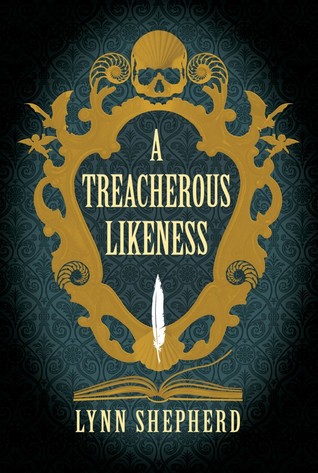You have no items in your cart. Want to get some nice things?
Go shopping It’s London, 1850, and private detective Charles Maddox has just been given a new case. Sir Percy Shelley and his wife are being harassed by someone threatening to make public certain facts about the Romantic poet Percy Bysshe Shelley’s early life. The Shelleys assure Charles that the stakes are high: if these details were made known, the consequences to the great poet’s name and reputation would be extremely damaging.
It’s London, 1850, and private detective Charles Maddox has just been given a new case. Sir Percy Shelley and his wife are being harassed by someone threatening to make public certain facts about the Romantic poet Percy Bysshe Shelley’s early life. The Shelleys assure Charles that the stakes are high: if these details were made known, the consequences to the great poet’s name and reputation would be extremely damaging.
At least, this is what they tell Charles. But who is this mysterious persecutor? What are the secrets the Shelleys are so desperate to hide? And what does it all have to do with Sir Percy’s frail old mother Mary?
Lynn Shepherd writes historical fiction that is both precise and intensely referential. Her Charles Maddox literary detective novels (this is our intrepid hero’s second outing) are based on well-known literature: the first, Tom-All-Alone’s, was a craftily distorted mirror-image of Dickens’s Bleak House, and A Treacherous Likeness draws on the life and works of the Romantics. And just as in Tom-All-Alone’s, there’s a subversive intelligence at work here. Shepherd isn’t afraid to take received wisdom about the Shelley household and twist into a ferociously dark new form.
Shepherd’s conclusions about the lives of the Shelleys and their oversexed circle of friends are, at times, startling. I admit, I don’t agree with some of them, but I have to grant that she is careful to back up even her wildest claims with source material – source material in which, as she admits in the afterword, the facts are often stranger than anything fiction could invent. Consider the evidence: after being the subject of an extensive Government surveillance operation before he was out of his teens, Shelley ran away to Switzerland with Mary Wollestonecraft Godwin and her half-sister Claire when Mary was only sixteen and Shelley’s first wife Harriet was still alive. Two women – Harriet and another one of Mary’s half-sisters, Fanny Imlay – then proceeded to kill themselves for love of him. And those are just the details that we know.
I’ve found the Shelleys (both Percy and Mary, who began Frankenstein when she was nineteen) fascinating ever since I first read about them, and so I’m touchy about any novel that tries to represent them. But rest assured, this is a presentation of their lives that manages to be both imaginative and rigorously researched. A Treacherous Likeness is a novel that will find favour with even the nerdiest fan of the Romantic poets. We get the greatest hits – William Godwin, Claire Clairmont and Byron, the great ghost story challenge, as well as some less-known side stories, like poor old Harriet and Fanny – and it’s all rolled up into a pacy historical mystery.
A Treacherous Likeness is written in a sarkily omnipotent voice that’s well aware that its characters are in the nineteenth century but its readers are in the twenty first century. The voice Shepherd employs reminds me a bit of the knowing narration of The Crimson Petal and the White, playing intelligently on the differences between the knowledge available to us and them. We’re better informed about the Shelleys’ lives, and about scientific principles and medical diagnoses, than Charles ever will be, and Shepherd makes use of that gap. She also does a nice recreation of the all-seeing omnipotent eye of the Dickensian narrator, zooming in and out of rooms, along streets and across the countryside. Shepherd has a beautifully light narrative touch, and her narrative voice is delightful and reassuring, someone we trust to take us on the journey she’s chosen.
Her protagonist Charles, by contrast, is wonderfully impulsive and thoughtless. He’s a great detective, but he’s often slightly rubbish at noticing what is going on around him at a personal level, and that mix of characteristics makes him a charmingly flawed hero who it’s a pleasure to spend time with.
For once, I’d have to argue that the Maddox mysteries are books where more knowledge of the subject is better. They are so heavily responsive to their base texts that they could really be described as fan fiction. I say this with the highest respect for fan fiction – Shakespeare, Virgil and Jean Rhys all did it, after all, so I have difficulty seeing why some people turn up their noses at it – but if you don’t know about Shelley’s life (or, in the case of Tom-All-Alone’s, if you haven’t already read Bleak House), you’re going to struggle to process what Shepherd is doing.
I think that these books are great. They are absolutely novels for a niche readership, but that’s fine. They never pretend to be anything else. If you are in their target demographic, you are in for a rare treat, and if you aren’t – well, you need to read Bleak House and a Shelley biography as fast as you can, just so you can join in the fun.
A Treacherous Likeness is out now from Corsair Press. Want to know more about Lynn? You can read our recent Q&A with her here.

About Robin Stevens
Robin started out writing literary features for Litro and joined the team in November 2012. She is from Oxford by way of California, and she recently completed an English Literature MA at King's College, London. Her dissertation was on crime fiction, so she can now officially refer to herself as an expert in murder (she's not sure whether she should be proud of that). Robin reviews books for The Bookbag and on her own personal blog, redbreastedbird.blogspot.co.uk. She also writes children's novels. Luckily, she believes that you can never have too many books in your life.





Historical fiction concerning Shelley via @LitroMagazine: A Treacherous Likeness by @lynn_shepherd out today. https://t.co/kh5D5pDv”